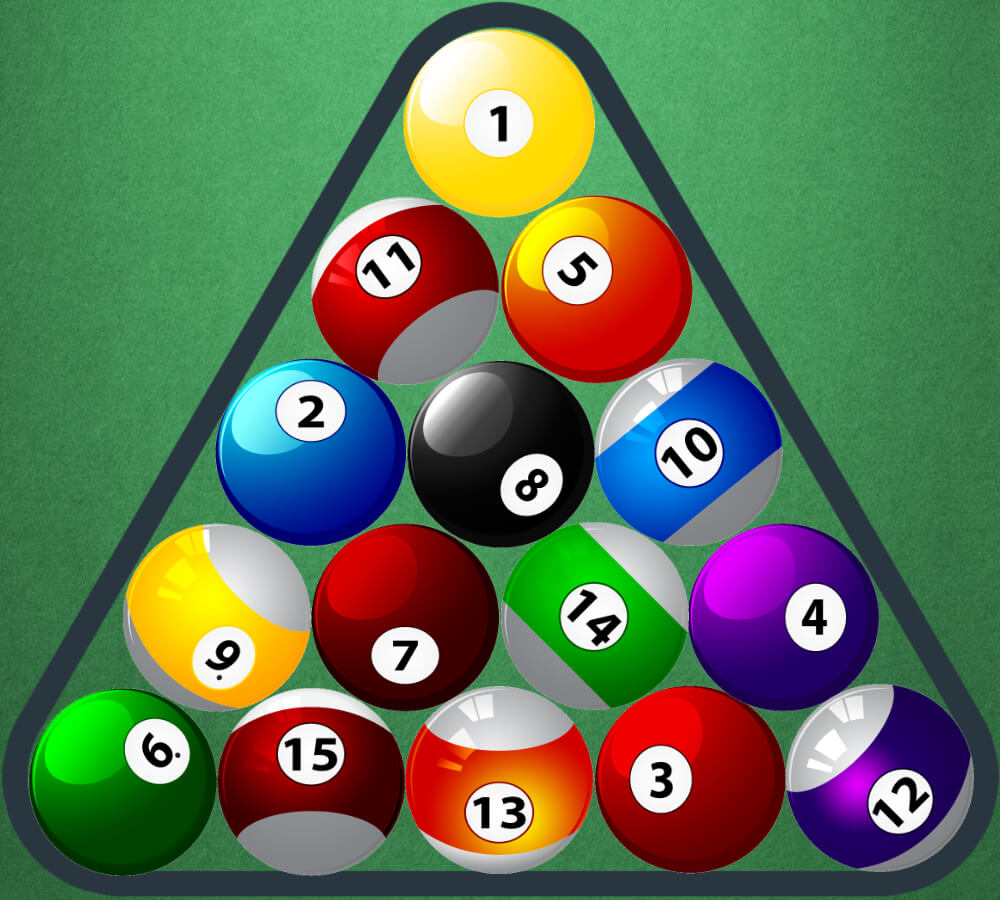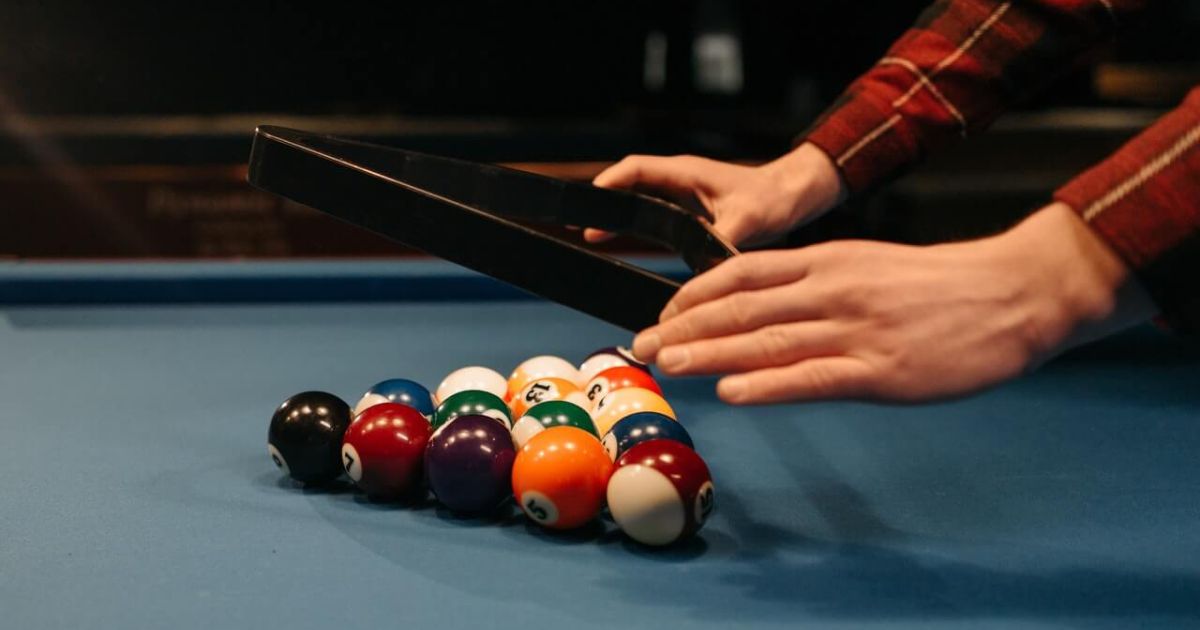Ever wondered how a seemingly simple act can significantly sway the outcome of a 9-ball billiards match? Mastering the rack setup in 9-ball billiards is not just a detail; it's the bedrock upon which a fair and competitive game is built.
The precision with which you arrange the balls at the start of a game can set the tone for the entire match. A well-executed rack can provide a balanced break, opening opportunities for strategic play and solid shot-making. Conversely, a poorly set-up rack can lead to a disadvantage from the first shot. Let's delve into the specifics.
Before the balls even begin to roll, the careful placement of the rack itself lays the foundation for whats to come. Think of it as the first strategic move in a game dominated by angles, precision, and a touch of luck. The following steps provide a guide to ensure a fair and competitive game:
The Fundamentals of Racking in 9-Ball
To begin, let's clarify the essential elements of setting up the 9-ball rack. As you prepare, you'll need a diamond-shaped rack. This differs from the triangle rack typically used in 8-ball.
The 'apex' ball, which is the 1-ball, is placed at the foot spot. This spot is a marked point located on the table near the middle of one of the short sides. Look for a small dot, often black or white, on the cloth. This dot serves as your guide to place the apex ball correctly. The remaining balls are then arranged around the apex ball to complete the diamond.
Heres a quick guide to setting up the rack:
- Foot Spot Alignment: Identify the foot spot on the table. This is where the apex of the diamond rack will be placed.
- Apex Ball Placement: Position the 1-ball (apex ball) directly on the foot spot. This is the most crucial placement of the rack.
- Diamond Formation: Arrange the remaining balls in a diamond shape around the 1-ball. Ensure they are tightly packed together.
- Corner Balls: Randomly place any stripe and any solid ball in the bottom corners of the diamond.
- Tight Packing: Ensure that all balls are touching each other to achieve a tight rack. This is critical for a balanced break.
- Rack Removal: Carefully remove the rack, making sure the balls stay in place.
The main ball in the rack is called the "apex" ball, and it is placed at a spot called the "foot spot". The foot spot is a marked point located on the table near the middle of one of the short sides. Place the apex ball (number 1 ball) on the foot spot of the table.
The rack is a diamond frame where youll place your balls. In seconds, you can quickly arrange nine balls in diamond form.
Key Considerations for the Perfect Rack
Racking the balls accurately is crucial for a fair game of pool, but there's more to it than just the placement of the balls. The way you set up the rack can greatly impact the flow and outcome of the game, making it essential to master this fundamental skill. Here's what to consider:
- Equipment Inspection: Always check the equipment before you begin. Make sure the balls are clean and free of any imperfections that might affect their roll. The rack should be in good condition, without any damage.
- Foot Spot Accuracy: Ensuring the apex ball is precisely on the foot spot is paramount. This gives a balanced break.
- Tight Configuration: The balls must be tightly packed. There should be no gaps between them. This is usually achieved by pressing the rack down on the balls to make them sit together as closely as possible. This is more easily done using a wooden rack than a flimsy plastic one.
- Balanced Break: Aim for a break that spreads the balls evenly, giving you or your opponent several possible shots.
- Removal Technique: When removing the rack, lift it straight up, so as not to disturb the tightly packed formation.
- Consistency: Practice the racking process consistently, and it will quickly become second nature.
- Opponent's Presence: When racking, allow your opponent to watch. This establishes trust and fairness in the game.
- Table Condition: Ensure that the table is level and the cloth is clean.
- Practice: The more you practice, the more confident you will become in the racking process.
Whether you're gearing up for a casual game at a local bar or hosting a friendly competition at home, mastering the art of racking is essential.
The correct way to rack the table for a game of 9-ball is to place the nine object balls inside a diamond rack. The rack is a triangle or diamond frame, often made of plastic, wood, or metal, where youll place your balls.
From properly positioning the balls to achieving tight and symmetrical racks, this guide will help you enhance your game and avoid any potential disadvantages.
Knowing the correct way to rack pool balls are an essential part of the game. It can make or break your game.
A loose break may set the tone for your opponent, and he can get that opportunity and win the game. You need to hit the ball in the right position with your pool cue so that you can pot one or two balls at least.
Additional Tips and Tricks
Beyond the basic steps, here are a few tips to refine your racking technique:
- Using a Racking Template: A racking template can be very useful. This tool ensures the balls are aligned and touching.
- Checking for Movement: Before removing the rack, double-check that the balls are not moving. A small shift can ruin the rack and affect the break.
- Adjusting for Cloth Condition: If the table cloth is new or particularly fast, you may need to adjust your pressure slightly to avoid disturbing the rack.
- Seeking Professional Advice: If you're serious about improving, consider learning from a professional instructor. National champion and PBIA master instructors can offer valuable advice.
The Importance of the Break Shot
The break shot is the first and perhaps most critical shot in 9-ball. A good break can scatter the balls, allowing you to gain a strategic advantage right from the start.
The objective of the break shot is to pot at least one ball while scattering the other balls across the table. A well-executed break allows for strategic play and can give a significant advantage early in the game.
Essential Pool Table Anatomy
Knowing the anatomy of a pool table is essential. Here is some basic information about the pool table:
- Rails: The sides of the table, typically made of wood and covered with cloth.
- Pockets: The six holes into which you aim to sink the balls.
- Cloth: The fabric covering the table's playing surface.
- Foot Spot: A marked spot where the apex ball of the 9-ball rack is placed.
- Head Spot: The spot on the head string, where the cue ball is placed.
Common Racking Mistakes and How to Avoid Them
Even experienced players can make mistakes when racking. Here are some common errors to watch out for:
- Loose Racks: Ensure all the balls are touching to avoid gaps that can ruin a break.
- Incorrect Foot Spot Placement: The apex ball must be on the foot spot for an accurate break.
- Disturbing the Rack: Avoid moving the balls when removing the rack by lifting straight up.
- Poor Ball Alignment: Always ensure the balls are well-aligned.
Racking in 8-Ball Versus 9-Ball
While this article focuses on 9-ball, it is crucial to know how to rack 8-ball. Here's a quick comparison:
In 8-ball, all 15 object balls are placed within a triangle rack, not a diamond. One solid and one striped ball are in the back corners. The 8-ball is placed in the center of the triangle. When playing 8-ball, one player will be solids and the other stripes.
Racking Practice and Refinement
The best way to master the rack is through practice. Try these exercises:
- Dry Runs: Practice racking without a break shot.
- Break Shot Practice: Use the break shot to get balls into pockets.
- Video Analysis: Record yourself racking to identify and correct any flaws.
- Game Simulation: Play practice games, focusing on the quality of your rack and break.
The Psychology of Racking
Racking isn't just a technical skill; it has a psychological aspect. A clean and consistent rack signals professionalism and can intimidate your opponent.
Here's how to use it to your advantage:
- Confidence: Showing confidence through a well-executed rack can be a psychological edge.
- Fairness: Racking accurately builds trust between players.
- Focus: Using each rack as a moment to center your focus helps improve overall performance.
Where to Learn More
There are several resources to further your understanding of racking and pool in general:
- Instructional Videos: Numerous videos on YouTube offer detailed guides on racking.
- Pool Books: Books written by professional players are a great source of insights.
- Pool Halls and Instructors: Visiting a pool hall and seeking advice from the players is invaluable.
Racking is a fundamental skill. By paying attention to these details, you can transform the start of your game and set a solid foundation for success.
In conclusion, mastering the art of the 9-ball rack is an essential step towards becoming a skilled pool player. Knowing what a pool rack is, how it's set up, and understanding the different rack settings between pool games, along with nine key considerations to perfect the rack every time, will help you enhance your game and avoid any potential disadvantages.
Remember, the perfect rack is a blend of precision, consistency, and attention to detail.
| Key Aspects of Racking in 9-Ball | Details |
|---|---|
| Objective | To arrange nine object balls in a diamond formation for a fair and balanced break. |
| Equipment |
|
| Foot Spot | Marked center point on the table, where the apex ball ("1" ball) is placed. |
| Apex Ball Placement | The "1" ball (apex ball) must be placed precisely on the foot spot. |
| Ball Arrangement |
|
| Tight Packing | Ensure all balls are touching each other to avoid gaps. |
| Rack Removal | Lift the rack straight up to maintain the ball formation. |
| Break Shot | Hit the balls using the cue ball to spread the balls across the table. |
| Common Mistakes |
|
| Tips for Improvement |
|
| Importance of 8-Ball | Learn the basics of racking for 8-ball, too, including the triangle rack, the placement of the 8-ball, and solid and striped balls. |
| Psychological Advantage |
|
Reference:
For additional information, you can consult the following websites:https://www.billiards.com/



Detail Author:
- Name : Sammie Nitzsche
- Email : lkoch@tromp.org
- Birthdate : 1972-07-12
- Address : 79913 Wanda Drive Apt. 218 East Erich, FL 46842-9071
- Phone : 1-207-433-2041
- Company : Miller LLC
- Job : Retail Salesperson
- Bio : Autem aspernatur consectetur aspernatur consequatur. Et quis eius provident minus voluptatem sunt. Provident quisquam fugit eum accusamus aliquam aut sapiente.